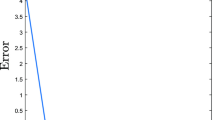Abstract
Asymmetric scaling of a square matrixA ≠ 0 is a matrix of the formXAX −1 whereX is a nonnegative, nonsingular, diagonal matrix having the same dimension ofA. Anasymmetric scaling of a rectangular matrixB ≠ 0 is a matrix of the formXBY −1 whereX andY are nonnegative, nonsingular, diagonal matrices having appropriate dimensions. We consider two objectives in selecting a symmetric scaling of a given matrix. The first is to select a scalingA′ of a given matrixA such that the maximal absolute value of the elements ofA′ is lesser or equal that of any other corresponding scaling ofA. The second is to select a scalingB′ of a given matrixB such that the maximal absolute value of ratios of nonzero elements ofB′ is lesser or equal that of any other corresponding scaling ofB. We also consider the problem of finding an optimal asymmetric scaling under the maximal ratio criterion (the maximal element criterion is, of course, trivial in this case). We show that these problems can be converted to parametric network problems which can be solved by corresponding algorithms.
Similar content being viewed by others
References
G. Aumann, “Über approximative Nomo-graphie, 1”,Bayerische Akademie der Wissenschaften, Mathematisch-Naturwissenschaftliche Klasse, Sitzungsberichte (1958) 137–155.
G. Aumann, “Über approximative Nomo-graphie, II”,Bayerische Akademie der Wissenschaften, Mathematisch-Naturwissenschaftliche Klasse, Sitzungsberichte (1959) 103–109.
M. Bacharach,Biproportional matrices and input-output change (Cambridge University Press, Cambridge, 1970).
F.L. Bauer, “Optimally scaled matrices”,Numerische Mathematik 5 (1963) 73–87.
F.L. Bauer, “Remarks on optimally scaled matrices”,Numerische Mathematik 13 (1969) 1–3.
A.R. Curtis and J.K. Reid, “On the automatic scaling of matrices for Gaussian elimination”,Journal of the Institute of Mathematics and Its Applications 10 (1972) 118–124.
G.B. Dantzig, W. Blattner and M.R. Rao, “Finding a cycle in a graph with minimum cost to time ratio with application to a ship routing problem”, in: P. Rosenstiehl, ed.,Theory of Graphs (Dunod, Paris, and Gordon and Breach, NY, 1967) 77–84.
G.B. Dantzig, “The assignment problem for matrix scaling”, Abstracts of talks presented at the ORSA/TIMS joint national meeting (1983) 78.
S.P. Diliberto and E.G. Straus, “On the approximation of a function of several variables by the sum of functions of fewer variables”,Pacific Journal of Mathematics 1 (1951) 195–210.
D.R. Fulkerson and P. Wolfe, “An algorithm for scaling matrices”,SIAM Review 4 (1962) 142–146.
D. Gale,The theory of linear economic models (McGraw-Hill, New York, 1960).
M. v. Golitschek, “An algorithm for scaling matrices and computing the minimum cycle mean in a diagraph”,Numerische Mathematik 35 (1980) 45–55.
M. v. Golitschek, “Optimal cycles in doubly weighted graphs and approximation of bivariate functions by univariate ones”,Numerische Mathematik 39 (1982) 65–84.
M. v. Golitschek, U.G. Rothblum and H. Schneider, “A conforming decomposition theorem, a piecewise linear theorem of the alternative, and scalings of matrices satisfying lower and upper bounds”,Mathematical Programming 27 (1983) 291–306.
M. v. Golitschek and H. Schneider, “Applications of shortest path algorithms to matrix scalings”, unpublished manuscript (1983).
R. Karp, “A characterization of the minimum cycle mean in a digraph”,Discrete Mathematics 23 (1978) 309–311.
R. Karp and J.B. Orlin, “Parametric shortest path algorithms with an application to cycle staffing”,Discrete Applied Mathematics 3 (1981) 37–45.
E.L. Lawler, “Optimal cycles in doubly weighted linear graphs”, in: P. Rosenstiehl, ed.,Theory of graphs (Dunod, Paris, and Gordon and Breach, NY, 1967) 209–214.
E.L. Lawler,Combinatorial optimization: Networks and matroids (Holt, Rinehart and Winston, NY, 1976).
N. Megiddo, “Combinatorial optimization with rational objective functions”,Mathematics of Operations Research 4 (1979) 414–424.
W. Orchard-Hays,Advanced linear programming techniques (McGraw-Hill, New York, 1968).
J.B. Orlin and U.G. Rothblum, “Algorithms for multiparameter network flow problems”, in preparation (1984).
U.G. Rothblum and H. Schneider, “Characterizations of optimal scalings of matrices”,Mathematical Programming 19 (1980) 121–136.
B.D. Saunders and H. Schneider, “Cones, graphs and optimal scalings of matrices”,Linear and Multilinear Algebra 8 (1979) 121–135.
J.A. Tomlin, “On scaling linear programming problems”,Mathematical Programming Study 4 (1975) 146–166.
W.T. Tutte, “A class of Abelian groups”,Canadian Journal of Mathematics 8 (1956) 13–28.
Author information
Authors and Affiliations
Additional information
This research was supported by NSF Grant ECS-83-10213.
Rights and permissions
About this article
Cite this article
Orlin, J.B., Rothblum, U.G. Computing optimal scalings by parametric network algorithms. Mathematical Programming 32, 1–10 (1985). https://doi.org/10.1007/BF01585655
Received:
Revised:
Issue Date:
DOI: https://doi.org/10.1007/BF01585655




